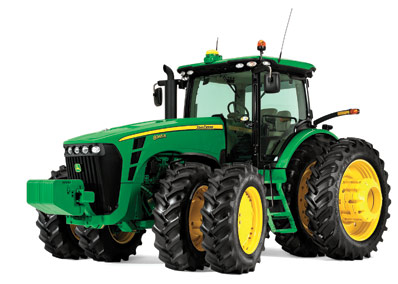July 6, 2010

In a recent special Webcast for media, John Deere gave a progress update on its Interim Tier 4 (IT4)-compliant engine solution and how this technology will be rolled out to dealers and producers in coming months. The regulations, which go into effect in 2011 for engines greater than 174 hp, call for the most drastic reduction in diesel engine emissions that EPA has ever called for.

Geoff Stigler, product marketing manager with JD Power Systems, says IT4 products for two of its engine platforms are already in production. These platforms are the 9.0-liter used in its 8R series row-crop tractors and construction loaders. The company also announced that combines will have Tier 3 engines through model year 2011.
“On March 30, our 9-liter engines received EPA certification,” Stigler says. “We shipped our first engine to an outside customer on April 6, 2010 — more than eight months before the regulation date. The message is, We’re ready.”
The engines have undergone nearly 240,000 total engine test hours and more than 42,000 vehicle test hours to validate performance. Stigler says both platforms will have the same fuel efficiency as its current Tier 3 engines. In addition, required maintenance intervals will be extended due to the fact that the engines will run cleaner.

As previously reported, John Deere will use Exhaust Gas Recirculation (EGR) technology in its IT4 engines to achieve the required emission reduction of 90% particulate matter (pm) and 45% NOx reduction with respect to Tier 3. (See “Next-generation engines: What buyers need to know now.") It is the same technology Deere used for its Tier 3 engines in the John Deere 8320R tractor, which up until last December held the record for fuel efficiency. (See “Most fuel-efficient row-crop tractors from AGCO.” )
Other tractor makers, including AGCO, Case IH, and New Holland, will use a different technology called Selective Catalytic Reduction (SCR) to achieve the required emission reductions. SCR requires the injection of a urea-based diesel exhaust fluid (DEF) into the exhaust stream to neutralize contaminants. (See “Reinventing the engine.” )
John Deere maintains that staying with EGR technology to meet IT4 regulations was the right choice for customers, both in terms of ease of use and cost of ownership.
“Ultimately we’ve designed a simpler, more convenient IT4 solution,” Stigler says. “Engineering EGR into the product before SCR allows customers to enjoy at least three more years of a single fluid solution with no reduction in performance, reliability, or fuel economy.”
Steve Meinzen, emission technology integration manager with John Deere, says that while a competitive new row-crop tractor equipped with SCR engine technology slightly bested John Deere’s fuel-efficiency record last year, tractor buyers must consider the total costs associated with each engine solution.

“As a result of using another consumable fluid or DEF or urea, one must think of fluid efficiency as opposed to just fuel efficiency, as urea is consumed at a rate of 3 to 5% of diesel fuel in an SCR solution,” Meinzen says. “We anticipate the OECD test will reflect this fluid efficiency starting with 2011 testing.”
To help its customers realize more cost savings, Deere is leveraging the strength of its dealer network to help farmers become more efficient vehicle operators. Using an exclusive new feature added to Deere’s Service Advisor, dealers will be able to access a vehicle’s engine electronic control unit (ECU) and determine the percentage of time the vehicle spends at load and rpm settings. Extensive sampling of customer machines revealed idle times averaging 30%.
“Reducing idle time can help farmers cut fuel use, while reducing hours that affect machine depreciation,” Meinzen says. “We plan to make customers aware of that 30% idle time and the value of reducing that time by shutting off their diesel-powered vehicles when not in use.”
Price increases also were discussed during John Deere��’s presentation. Effective January 1, 2011, the 8R series tractor with IT4-compliant engines will be priced around 5.7% higher than the current models.
The company has not announced its strategy to meet Final Tier 4 standards, which go into effect in 2014. But Meinzen says its IT4 engines will be used as a building block for Final Tier 4.
“Options are open to go either way [EGR or SCR],” Meinzen says. “We are open to all the technology solutions as we move to Final Tier 4.”
He adds, “It is possible to meet the final reduction using EGR, but work needs to be done to maintain performance and fuel economy.”
You May Also Like




